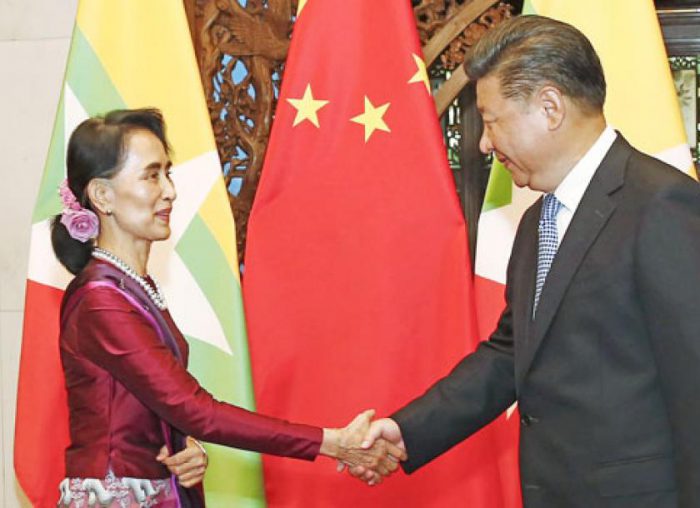
File Picture Courtesy : The Myanmar Times
On Aug 24 the UN Human rights Council published a report affirming that the Myanmarese Army led a pogrom in2017 in Rakhine province that claimed the lives of more than 10000 Rohingyas” was premeditated and amounted to genocide” and caused mass exodus of 7.23 lakh Rohingyas to Bangladesh. This verdict will go down as a black day in the history of Myanmar signalling the failure of its diverse peoples to build first , a nation and second, a modern state founded on Rule of law, respect for human rights and democratic institutions of governance even after 7decades of independence.
No wonder that in the 2017 Global Democracy index of the Intelligence unit of the Economist magazine Myanmar was placed in the” hybrid” category of States and ranked 110th in 184 nation index. A hybrid state is defined as a state which combines democratic traits with the authoritarian ones the latter dominating the policy and decision making in critical areas of governance such as defence and has ” an anemic Rule of law and criminal justice system”.
The Myanmarese state meets the criteria because even after 2015 election and victory of Madam Aung san Suu Kyi’s NLD , the fact that under the extant 2008 Constitution Armed forces hold 25% of seats in the Legislature and control defence, internal securityand border affairs which is unthinkable in a democracy as government servants cannot be lawmakers .This indicates a severe democracy deficit in Myanmar.
Ironically this makes Myanmar a natural ally of China as China too is placed in the hybrid category and ranked 139th in the index. There is an important commonality: the Myanmarese Army like the PLA of China is a politicised force and not a professional army like the Indian Army as it emerged first as a Revolutionary army during the second world war and trained and equipped by the Japanese. The important role played by Gen Aung San who was not a professional soldier in negotiations with the British for independence made the Army an integral part of the state power structure.
It’ is this failure to build a nation that enabled China to intervene in the ethnic insurgencies in border regions from 1949- 50. It is known that in April 2017 PLA and the Myanmarese Army have worked out a common approach to maintenance of peace and promotion of border trade. And presently because of high Chinese influence on the Northern Alliance comprising the Kachin, Mon,Taang ,Was and Arakan armed groups China plays an important though indirect role in the Myanmarese state’s ongoing peace process with 16 ethnic armed organizations( EAO) to end 60 years of civil war. This is a major initiative of Aung San Suu Kyi after she won the 2015 Election and called” the Second Panglong conference” because her father held the first conference at Panglong in 1947 to end ethnic unrest.
Right from the beginning the Army had to take the Chinese border troops on board because the insurgency affected areas were mostly in the regions bordering China. This cooperation at the ground level grew stronger during long spells of military Rule as by 1990 Burma had become “China’s principal political and military ally in South East Asia “. According to a SIPRI 2011report since 1988 China supplied about 90% military hardware to Myanmar covering military transport, warplanes and battle ships. This enabled Myanmar to build a new Navy as during 2013-15 China supplied 20 C802 anti Ship missiles,10 NG 1830mm naval guns,2sets each of surface search , fire control and air search radar.
In 2012 -16, Myanmar acquired 2 frigates, 65 anti ship missiles of advanced technology systems and 2 sets of NG 1830mm naval guns. In 2015 China extended USD 256 million term loan to Import 26 China built JF 17 fighter aircraft. In the same period Myanmarese manufacturing capacity in building warships has been enhanced and the new warships built in Myanmarese shipyards heavily feature Chinese systems.
The Sino Myanmarese military Cooperation therefore is a strategic relationship and unlikely to change even though Myanmar conducted her first joint warfare training exercise with India in November 2013 in Meghalaya and India supplied 2 LW 04 Air search radar and 3 sets of sonar, artillery pieces, patrol boats and night vision devices. Expanding defense Cooperation with Myanmar is essential for success of Indias Act East Policy to balance the Chinese influence.
From a strategic perspective, the China Myanmar economic corridor-a part of the Belt and Road initiative of China is founded on the long standing defense Cooperation and the fact that China firmly stood by the junta during decades of Myanmar’s isolation. The other reason is that the Chinese view Myanmar as the” land bridge to reach the Indian ocean” resolving thereby her “Malacca dielemma”, that is, overdependence on the straits for movement of her middle East crude oil and gas imports critical for the Chinese economy. As China annually draws about half of 382.6 million Tonnes of crude oil from the middle East ,movement of Oil tankers entirely through the straits of Malacca is a “strategic risk” that China seeks to avoid. Thus operationalization of Oil and gas pipelines from Kyaukphyu on the Bay of Bengal coast to Ruili in Yunnan province of China for which China invested about USD 7.5 billions are seen as Chinese strategic footprints in this direction.
The deep sea port project at Kyaukphyu- though scaled down to 2 berths at an investment of USD 1.3 bn and a Special Economic Zone now under construction will make it firmer. On the trade front, the size of China Myanmar trade is a robust USD 8bn now as compared to Myanmar’s India trade of USD 1.6 bn; and Myanmarese imports from China being mainly electronics, heavy machinery and power generation machines are critical for her development. Further, since 1988 China’s cumulative share of FDI in Myanmar has been about 25% of the total USD 80 bn and primarily in infrastructure.
The implications of this situation for the North East are immense. First, the extension of the BRI to Bangladesh through Myanmar is now a distinct possibility: second once the Kaladan multi modal transport project is commissioned in 2019 convergence of interest of Myanmar and India will be more pronounced . Third, construction of the railway link between Kakarbhitta in Nepal and Siliguri as agreed in the recent BIMSTEC meet at Kathmandu will boost not only Nepal Bangladesh but Nepal North East trade and Technical Cooperation.
These could really be a game changer of development of North East provided the Regional economy is restructured to build complimentarities with Bangladesh, Myanmar and ASEAN economies . A precondition for this to happen is to end ” ethnic insurgencies”and policies and systems which incentivise such self destructive activities. For this,a Myanmar type “Panglong conference” with insurgent groups of North East to resolve the issues is the need of the hour for success of the Act East policy and in this NEC could be the catalyst.
( The writer is a retired IAS officer of the Assam – Meghalaya cadre and has served as Scientific Consultant in the office of the Principal Scientific Advisor to the Government of India)


















